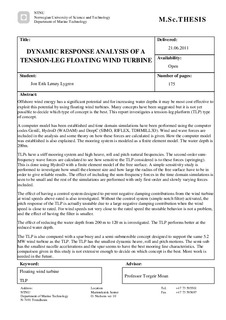| dc.contributor.author | Lygren, Jon Erik Lønøy | nb_NO |
| dc.date.accessioned | 2014-12-19T12:06:39Z | |
| dc.date.available | 2014-12-19T12:06:39Z | |
| dc.date.created | 2012-02-08 | nb_NO |
| dc.date.issued | 2011 | nb_NO |
| dc.identifier | 492822 | nb_NO |
| dc.identifier.uri | http://hdl.handle.net/11250/237964 | |
| dc.description.abstract | Offshore wind energy has a significant potential and for increasing water depths it may be most cost effective to exploit this potential by using floating wind turbines. Many concepts have been suggested but it is not yet possible to decide which type of concept is the best. This report investigates a tension-leg platform (TLP) type of concept.
A computer model has been established and time domain simulations have been performed using the computer codes GeniE, HydroD (WADAM) and DeepC (SIMO, RIFLEX, TDHMILL3D). Wind and wave forces are included in the analysis and some theory on how these forces are calculated is given. How the computer model was established is also explained. The mooring system is modeled as a finite element model. The water depth is 200m.
TLPs have a stiff mooring system and high heave, roll and pitch natural frequencies. The second-order sum-frequency wave forces are calculated to see how sensitive the TLP considered is to these forces (springing). This is done using HydroD with a finite element model of the free surface. A simple sensitivity study is performed to investigate how small the element size and how large the radius of the free surface have to be in order to give reliable results. The effect of including the sum-frequency forces in the time domain simulations is seen to be small and the rest of the simulations are performed with only first-order and slowly varying forces included.
The effect of having a control system designed to prevent negative damping contributions from the wind turbine at wind speeds above rated is also investigated. Without the control system (simple notch filter) activated, the pitch response of the TLP is actually unstable due to a large negative damping contribution when the wind speed is close to rated. For wind speeds not very close to the rated speed the unstable behavior is not a problem, and the effect of having the filter is smaller.
The effect of reducing the water depth from 200 m to 120 m is investigated. The TLP performs better at the reduced water depth.
The TLP is also compared with a spar buoy and a semi-submersible concept designed to support the same 5.2 MW wind turbine as the TLP. The TLP has the smallest dynamic heave, roll and pitch motions. The semi-sub has the smallest nacelle accelerations and the spar seems to have the best mooring line characteristics. The comparison given in this study is not extensive enough to decide on which concept is the best. More work is needed in the future. | nb_NO |
| dc.language | eng | nb_NO |
| dc.publisher | Norges teknisk-naturvitenskapelige universitet, Fakultet for ingeniørvitenskap og teknologi, Institutt for marin teknikk | nb_NO |
| dc.title | Dynamic response analysis of a tension-leg floating wind turbine | nb_NO |
| dc.title.alternative | Dynamisk responsanalyse av en flytende strekk-stag vindturbin | nb_NO |
| dc.type | Master thesis | nb_NO |
| dc.contributor.department | Norges teknisk-naturvitenskapelige universitet, Fakultet for ingeniørvitenskap og teknologi, Institutt for marin teknikk | nb_NO |
